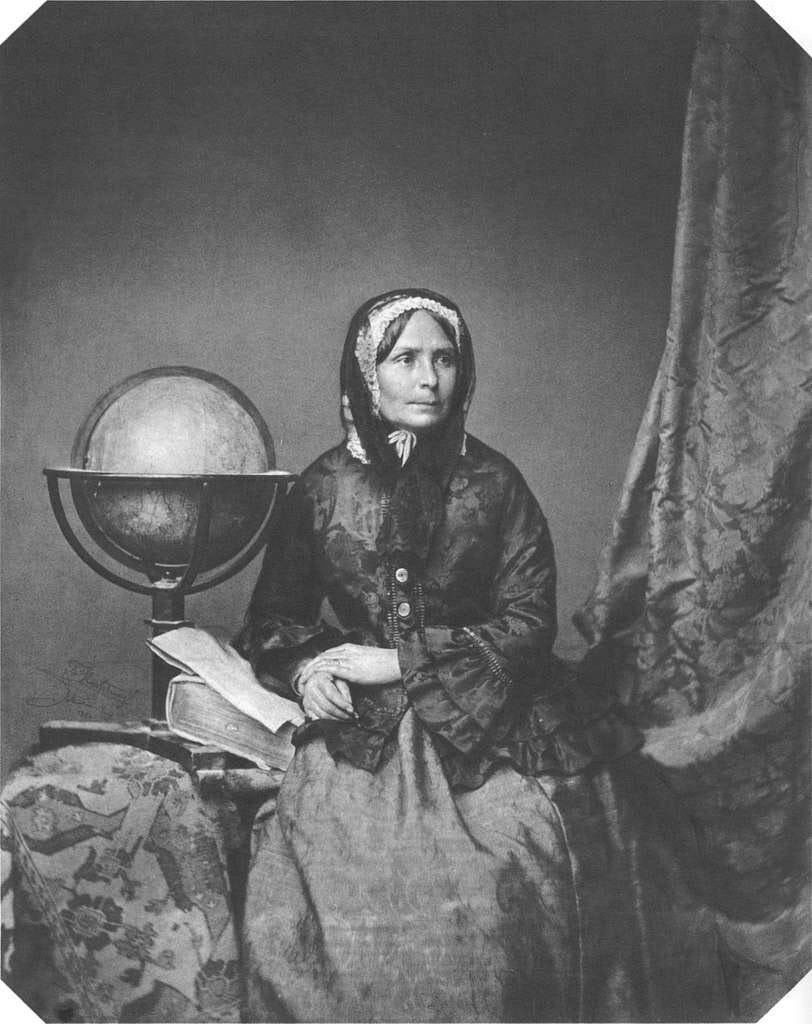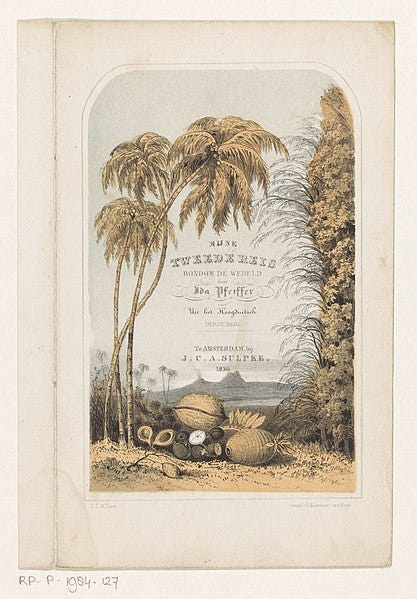Meet... Ida Laura Pfeiffer
This intrepid explorer followed her childhood dream, embarking on two solo round-the-world trips in the 19th-century and becoming a best-seling author in the process.

One of the earliest known female travel writers, Ida Pfeiffer completed a host of solo trips to places as far flung as Madagascar, Hong Kong and Ecuador. She is described as neither wealthy, educated or young, embarking on most of her adventures from the age of 45, once both her sons had left home. Her courage and determination to follow in the footsteps of some of her male adventurer heroes is incredible by any standards, never mind that this took place as early as 1842.
Born in Vienna on 14th October 1797 as Ida Laura Reyer, this young explorer was lucky enough to travel far afield from an early age. Pfeiffer was just five years old when she visited Palestine and Egypt. This experience must have influenced her strongly, as Pfeiffer’s longing to visit far-off lands stayed with her for life.
Pfeiffer herself later wrote: “When I was but a little child, I had already a strong desire to see the world. Whenever I met a travelling-carriage, I would stop involuntarily, and gaze after it until it had disappeared.”1

Sadly, Pfeiffer’s father, a wealthy textile manufacturer who had allowed his daughter the same education as her five brothers, died in 1806 when Pfeiffer was eight. His death marked an end to Pfeiffer’s childhood travels - her mother Anna preffered for her daughter to follow a more conventional upbringing, insisting that Pfeiffer wore dresses and learn the piano.
Yet Pfeiffer continued to dream of adventures, indulging in the works of contemporary writers such as Daniel Defoe and Alexander von Humbolt, an explorer and naturalist.
Forced to marry a man 24 years her senior, the 22-year-old Pfeiffer would spend the next 23 years raising two sons and struggling to make ends meet. It was only when her sons had both grown up and found employment of their own that Pfeiffer set off on her longed for travels once again. She was 45 years old.

The first trip saw Pfeiffer revisiting the Middle East in 1842. Her publisher would later note how “in her earliest youth, [Pfeiffer] earnestly desired to perform this journey; descriptions of the Holy Land were perused by her with peculiar interest, and a book of Eastern travel had more charms for her than the most glowing accounts of Paris or London.”
Pfeiffer’s journey would cover Belgrade, Constatinople, Rhodes, Cyprus, Jaffa, Jerusalem, Bethlehem, Nazareth, Beirut, Damascus, Alexandria, Cairo, the Giza pyramids, Malta, Paleromo, Naples, Rome, Siena, Florence, Bologna, and Ferrara (with many other stops in-between).
Along the way, Pfeiffer kept a detailed diary of her adventures, with headings such as ‘Discomfort and bad management on board the steamer,’ ‘wild dogs’, ‘female beauty’, ‘oppressive heat,’ and ‘brutality of the Italian mob.’

In her opening chapter, Pfeiffer muses on the perceived dangers of her trip: “My friends and relations attempted in vain to turn me from my purpose by painting, in the most glowing colours, all the dangers and difficulties which await the traveller in those regions. ‘Men’, they said, ‘were obliged gravely to consider if they had physical strength to endure the fatigues of such a journey, and strength of mind bravely to face the dangers of the plague, the climate, the attacks of insects, bad diet, etc. And to think of a woman’s venturing alone, without protection of any kind, into the wide world, across sea and mountain and plain,—it was quite preposterous.”2
But venture alone, Pfeiffer did. Over the course of nine months, Pfeiffer had “seen much and endured many hardships.”3 In her diary entries Pfeiffer seems to actively seek out beauty, marveling regularly at “graceful minarets”, charming gardens rich in fruit trees, awe-inspiring views found by climbing up steps or hiking up hills whenever the opportunity strikes, and “the loveliest women,” such as those in Smyrna who wear “little round Fex caps” beneath their “rich hair.”
Of course, the trip wasn’t without its dangers, as Pfeiffer was more than fully aware, having prepared a will and “arranged all [her] wordly affairs in such a manner that, in the case of [her] death, … [her] family should find everything perfectly arranged.”4 Pfeiffer fell sick a number of times; in Palermo she was confined to her room for a fortnight, where she would sit on the balcony writing observations about the “bustling, lively populace,” which she described as “very ill-behaved, boisterous, and quarrelsome.”5

Carrying out much her travels by boat meant that Pfeiffer could not escape sea sickness, describing "equinoctial gales" and “dreadful howling of the waves” on the Black Sea.6 Along the journey Pfeiffer would experience sunburn in Nazareth, get lost in a Beyrut bazaar, and have her purse stolen at the Pyramids of Giza.7
“In perfect health” Pfeiffer returned home in early December. She would say of her travels that she “had found very few things as I had imagined them to be.”8 Her account of her adventures (written only to be shared with family and friends) caught the interest of a publisher and was published as ‘A Visit to the Holy Land, Egypt, and Italy.’ The book was eventually translated into seven languages, becoming hugely popular in Europe.9
With her first travel book a resounding success and having received a handsome 700 florins,10 Pfeiffer was able to embark on another quest in 1845 to Scandinavia and Iceland. This trip would mark the start of Pfeiffer’s interest in specimen collecting. The insects, plants and mineral specimens that Pfeiffer would find during this and other advenutres would later be sold to London’s British Museum, Berlin’s Museum für Naturkunde, and Vienna’s Naturhistorisches Museum.

The money from these sales – as well as from her book sales – helped to fund two round-the-world trips (first via South America, China, India and Greece, then via South Africa, Singapore, and North America), and finally an 1857 expidition to Madagascar.
This final trip ended in tragedy for Pfeiffer. She made aquaintance with Joseph-François Lambert, who unbeknownst to her, was planning a conspiracy to overthrow the queen of Madagascar. Pfeiffer inadvertently got associated with the coup and got expelled from the country. On the journey home, Pfeiffer caught a malaria-type disease from which she would never fully recover.
At her brother’s home in Vienna, on 27th October 1858, Ida Laura Pfeiffer sadly died. She was 61 years old.

It is without doubt however that Pfeiffer left a remarkable legacy behind. In the mid 19th-century Pfeiffer was one of the most famous women in the world.11 Charles Darwin even cited some of the findings from her travels in his book, Descent of Man. While over time, Pfeiffer’s name has become less well known , there are many places in which her influence can still be felt. This is particularly true in Vienna where Pfeiffer’s grave was the transferred to a place of honor in the Vienna Central Cemetry in 1892. She was the first woman to be placed there. The University of Vienna established a Professorship in her name in 2018.
Although not a household name, Pfeiffer’s remarkable story continues to enchant those who discover it. Turning her escapades into over a dozen popular books and journals, some translated into seven languages, is an astounding achievment for anyone, never mind that it took place around 180 years ago. As the first known female solo traveller, it is without doubt that Ida Pfeiffer inspired other women to become travel writers and follow in her boundary-crossing wake.
Pfeiffer, Ida (1852). Visit to Iceland and the Scandinavian North. London: Ingram. Retrieved 9 October 2019.
Pfeiffer, Ida (1844). A Visit to the Holy Land, Egypt, and Italy. Translated by H. W. Dulcken. See: https://www.gutenberg.org/files/12561/12561-h/12561-h.htm
https://www.gutenberg.org/files/12561/12561-h/12561-h.htm
https://www.gutenberg.org/files/12561/12561-h/12561-h.htm
https://www.gutenberg.org/files/12561/12561-h/12561-h.htm
https://www.gutenberg.org/files/12561/12561-h/12561-h.htm
https://www.gutenberg.org/files/12561/12561-h/12561-h.htm
https://www.gutenberg.org/files/12561/12561-h/12561-h.htm
https://www.quest-cdecjournal.it/an-unusual-traveler-ida-pfeiffers-visit-to-the-holy-land-in-1842
https://www.quest-cdecjournal.it/an-unusual-traveler-ida-pfeiffers-visit-to-the-holy-land-in-1842
‘Snakes, Tigers and Cannibals’ by John van Wyhe, article in BiblioAsia, Jan - March 2020




